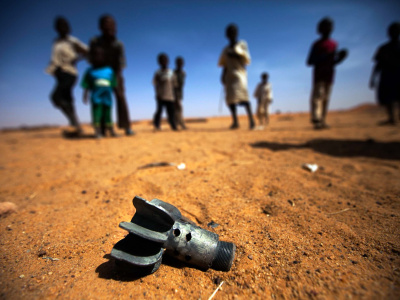
What is the new European Consensus on Development for?
While the new European Consensus on Development moves aways from "business as usual", there are still many open questions that need to be solved.
The EU institutions are now discussing a new European Consensus on Development to replace the one they agreed on in 2005. However, it would seem that there is one issue they need to resolve first: what exactly should the objective of a new Consensus be and what is it expected to achieve?
It was to be expected that the Commission’s proposal for this new Consensus from last November would set the document firmly in the context of the United Nation’s 2030 Agenda for sustainable development. To make the case for this, the proposal is structured around the UN’s ‘5Ps’ summary of the Agenda: People, Planet, Prosperity, Peace and Partnerships, explaining how the EU would contribute to each of them point by point, though in a somewhat mechanical way.
The proposal even suggests that the success of the new Consensus would be assessed at midterm against the 2030 Agenda, rather than against the priorities that the EU sets itself. The new proposal expresses the hope the member states would also adopt and follow the Consensus, but without going into detail regarding how they would do so. Again, this is not a surprise since Part I of the 2005 Consensus already applied to the whole EU, members states as much as institutions. While this is positive, it does raise the question of how much member states will be willing to play ball, given that their support for implementing Part I of the 2005 Consensus was often more tacit than explicit.
However, the European Parliament and the member states will probably agree on using the 2030 Agenda as the context for the new Consensus, as they were both strong supporters of EU involvement in the discussions leading up to the agreement on the Sustainable Development Goals (SDGs), they also need a document that outlines a strategy that the EU intends to follow in achieving the Agenda’s goals. More specifically, they want to agree on a strategic document that spells out how the funds for development cooperation in the EU budget and in the European Development Fund, managed by the EU institutions, will be used so they can hold the Commission to account.
For the current Multiannual Financial Framework (MFF), the aim was to have ‘policy-driven instruments’, that is each funding instrument should have a clear policy document to guide its use. There is no reason to change this principle for the future MFF, which will cover the period from 2017 to 2021, that the new Consensus will underpin. Yet, the proposal does not square easily with this task.
The Commission’s proposal for the new Consensus does provide some indication in various places of a few of the priorities envisaged such as spending on least developed countries and fragility, or using development cooperation funds as a catalyst to encourage other forms of finance for development (such as tax revenue collection or private investment for instance). Although these issues are dotted around the proposal, they are not brought together into a clear strategy.
Moreover, while many of the elements of past policy in the 2005 Consensus and the 2011 Agenda for Change are to be found again in the new proposal, others are not visible, though, one might argue, they are still relevant. For instance, there are clear references to the ‘More Aid’ and ‘Better Aid’ priorities of the current Consensus in the shape of references to the UN’s longstanding, but still unmet, 0.7% official development assistance (ODA) to gross national income target and the 2011 Busan Outcome Document on aid effectiveness (though interestingly not to the more recent 2014 High-Level meeting of the Global Partnership for Effective Development Co-operation). Yet while the Agenda for Change’s policy on ‘graduation’ (which says that those developing countries that get richer will no longer receive ODA from the European Union) and the focus on governance to improve impact may be implicit, they are not clearly spelt out.
Thus, for the purposes of accountability and the regular interaction between the Commission and the EU ‘budgetary authority’ (the European Parliament and the Council), it seems that the new Consensus will need some form of annex or additional document to spell out a strategy for the use of EU development cooperation funds. Do we then just come back to the solution put forward in the 2005 Consensus of having a Part II for this purpose? The current proposal would then serve the same ‘Vision’ role as the existing Part I. But then, if the role of the EU institutions is spelt out in more detail, should some indication of the role of the member states not also be laid out so as to move towards some clearer form of division of labour as agreed back in the EU’s 2007 Code of Conduct on this topic?
A new Consensus for ‘sustainable’ Development
Despite these open questions, there are some advantages to the current proposal for a new Consensus. In particular, the close link to the 2030 Agenda shows that the EU is willing to join in the global effort to implement its commitments on this account. This should play well in the international arena of the UN High-Level Political Forum. Publishing the proposal for the new Consensus on the same day as the other proposal for internal EU implementation of the Sustainable Development Goals also shows the EU’s intention to respect the principle of universality and pursue the SDGs at home in the EU as well as externally.
What is less evident, though equally important, is the fact that the 2030 Agenda points the way to a new type of international cooperation, one that goes beyond the traditional North-South model. Unlike the Millennium Development Goals that originated in the UN and had a strong donor drive that came to be very closely associated with ODA, the 2030 Agenda and the accompanying Addis Ababa Action Agenda are based on a model that assumes contributions (financial and other Means of Implementation) and efforts from all sides. By being seen to buy into this agenda, the EU also shows itself open to new ways of working and not just business as usual. The current proposal for the new Consensus is, therefore, less about aid and more about sustainable development.
So, what is the new Consensus for?
Should it spell out how the European Union as a whole, through its international cooperation effort, will support other countries in achieving the SDGs? Or is it simply a European strategy on the use of EU aid against which the European Parliament can judge progress? The answer is probably a bit of both, but, if so, how do you write such a strategy without falling back into the old rut of donor-driven aid? This is the key question the EU institutions still need to resolve in defining their new Consensus.
The views expressed here are those of the author and not necessarily those of ECDPM.



